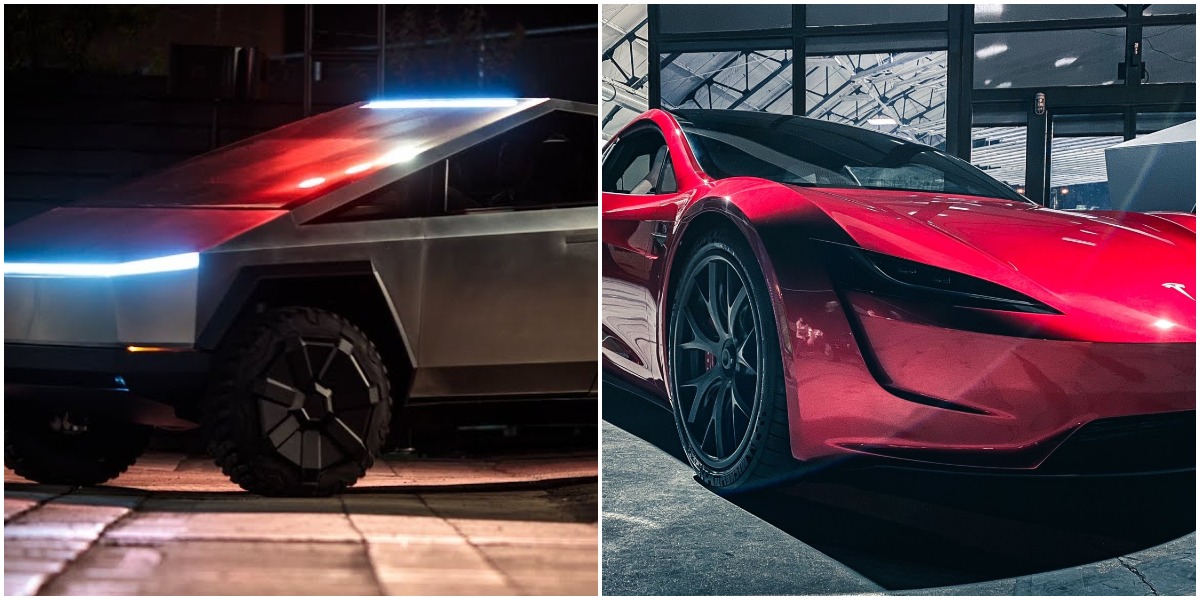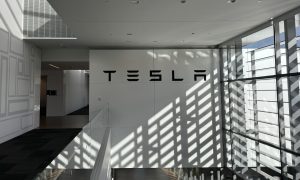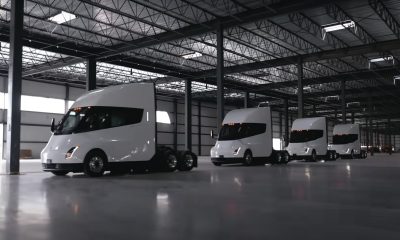

News
Tesla’s Battery strategy is in preparation for two of its most anticipated vehicles
Tesla has continued to attempt to improve its battery packs and cells despite being the industry leader in EV battery tech. Interestingly enough, the electric car company located in Silicon Valley has had some of the best vehicles in terms of EV range in the past ten years. While other car companies were struggling to equip their attempts at electric cars with 100 miles of usable range, Tesla was and has been pushing the envelope since the original Roadster in 2008.
But even though the company has facilitated several vehicles in its fleet to have over 300 miles of range, and one with over 400 miles, it hasn’t been enough to let Tesla’s battery engineers rest. Even though the Model S Long Range Plus configuration packs 402 miles of electric range, which is plenty for most drivers, Tesla has several cars in the works that pack considerably more range than that. These are also not your “run of the mill” EVs, either. They are the Tri-Motor Cybertruck and the next-gen Roadster.
Batteries are what drive an EV to be all that it can be. They are responsible for the range and the performance of the car, along with the motors and engineering of the chassis and body. However, battery tech is ultimately what decides if a vehicle is going to be a successful electric car or just another one to add to the list of underperforming automobiles.
The key to building a great electric car, like anything else, is starting at the foundation. When you want to make a great pizza, you start with great dough. When you want to make a great EV, you start with the battery cells.
The problem with batteries is that there are no two cells that are the same when the materials that are used within are concerned. Not only that, but sometimes the elements that make some batteries stable and help with energy density are controversial. This is the case with cobalt.
But before I go into a spiel about Tesla’s use of cobalt and how the company responsibly sources it, let’s stay on topic.
Tesla’s battery teams in Canada, led by Jeff Dahn at Dalhousie University, released a new paper this week that indicated an electrolyte solution could contribute to increased battery energy density, and could lead to an extended lifespan.
This is a preview from our weekly newsletter. Each week I go ‘Beyond the News’ and handcraft a special edition that includes my thoughts on the biggest stories, why it matters, and how it could impact the future.
A big thanks to our long-time supporters and new subscribers! Thank you.
The solution would be used to combat the effects of degradation, and would ultimately lead to a longer life span and increased energy density. Enter the Tri-Motor Cybertruck and Roadster.
Both of these cars have range ratings that are well above the Model S Long Range Plus variant. The Cybertruck’s Tri-Motor will have 500+ miles of range, and the Roadster will have 620 miles.
However, Tesla’s current cells are not capable of holding this amount of range. If the batteries are not capable of holding excessive amounts of energy density, they will not perform in the fashion that they were intended. Therefore, Tesla has to continue developing its cells to promote longer-range driving and a long lifespan.
Starting with the Cybertruck, which has an estimated range of “500+ miles,” according to Tesla’s website. Currently, Tesla does not have a battery pack released that is capable of that kind of range, so the batteries must improve. The Tri-Motor setup will certainly help with the towing capacity and acceleration. Still, the battery pack within the Cybertruck has to work efficiently to not only supply power to those motors, but it also has to maintain energy so it can keep range at a reasonable level.
With the Roadster, things are slightly different. This car will (more than likely) not be towing things or have excessive amounts of cargo in the back, so there isn’t as much involved with maintaining range through laborious work. However, it is one of the fastest cars ever made, and Elon Musk has said in the past that the range of the Roadster will be over 1,000 kilometers or 621 miles.
Ultimately, the development of Tesla’s cells has to continue to improve. Obviously, the battery packs for both of the vehicles that were talked about in this article will have battery packs that are larger than the 100 kWh packs that Tesla puts in the Performance variants of the Model S and Model X. But there is a chance that Tesla equips the Cybertruck and Roadster with smaller, more energy-dense batteries like the 2170 cells that are used in the Model 3 and Model Y.
Lucid’s reveal of the 517-mile range that their new EV, the Air, has, certainly must have lit a fire under the rear-ends of Tesla’s battery engineers. Tesla has had a reputation of being the EV company with the best range, and now that Lucid “technically” has the title for that, even though the car isn’t in production, Tesla will likely be gearing up for a takeback of that label.
Tesla’s battery strategy from here on out will be interesting considering other auto companies have proven they are capable of competing in terms of EV range. There is still the fact that Tesla is actually producing these cars on a massive scale and we know that the company’s cars can perform, we don’t know this about the other vehicles yet.
Please consider Subscribing and joining me next week as I go ‘Beyond the News’
News
Tesla begins Robotaxi certification push in Arizona: report
Tesla seems serious about expanding its Robotaxi service to several states in the coming months.

Tesla has initiated discussions with Arizona transportation regulators to certify its driverless Robotaxi service in the state, as per a recent report from Bloomberg News. The move follows Tesla’s launch of its Robotaxi pilot program in Austin, Texas, as well as CEO Elon Musk’s recent comments about the service’s expansion in the Bay Area.
The Arizona Department of Transportation confirmed to Bloomberg that Tesla has reached out to begin the certification process for autonomous ride-sharing operations in the state. While details remain limited, the outreach suggests that Tesla is serious about expanding its driverless Robotaxi service to several territories in the coming months.
The Arizona development comes as Tesla prepares to expand its service area in Austin this weekend, as per CEO Elon Musk in a post on X. Musk also stated that Tesla is targeting the San Francisco Bay Area as its next major market, with a potential launch “in a month or two,” pending regulatory approvals.
Tesla first launched its autonomous ride-hailing program on June 22 in Austin with a small fleet of Model Y vehicles, accompanied by a Tesla employee in the passenger seat to monitor safety. While still classified as a test, Musk has said the program will expand to about 1,000 vehicles in the coming months. Tesla will later upgrade its Robotaxi fleet with the Cyercab, a two-seater that is designed without a steering wheel.
Sightings of Cybercab castings around the Giga Texas complex suggests that Tesla may be ramping the initial trial production of the self-driving two-seater. Tesla, for its part, has noted in the past that volume production of the Cybercab is expected to start sometime next year.
In California, Tesla has already applied for a transportation charter-party carrier permit from the state’s Public Utilities Commission. The company is reportedly taking a phased approach to operating in California, with the Robotaxi service starting with pre-arranged rides for employees in vehicles with safety drivers.
News
Tesla sets November 6 date for 2025 Annual Shareholder Meeting
The automaker announced the date on Thursday in a Form 8-K.

Tesla has scheduled its 2025 annual shareholder meeting for November 6, addressing investor concerns that the company was nearing a legal deadline to hold the event.
The automaker announced the date on Thursday in a Form 8-K submitted to the United States Securities and Exchange Commission (SEC). The company also listed a new proposal submission deadline of July 31 for items to be included in the proxy statement.
Tesla’s announcement followed calls from a group of 27 shareholders, including the leaders of large public pension funds, which urged Tesla’s board to formally set the meeting date, as noted in a report from The Wall Street Journal.
The group noted that under Texas law, where Tesla is now incorporated, companies must hold annual meetings within 13 months of the last one if requested by shareholders. Tesla’s previous annual shareholder meeting was held on June 13, 2024, which placed the July 13 deadline in focus.
Tesla originally stated in its 2024 annual report that it would file its proxy statement by the end of April. However, an amended filing on April 30 indicated that the Board of Directors had not yet finalized a meeting date, at least at the time.
The April filing also confirmed that Tesla’s board had formed a special committee to evaluate certain matters related to CEO Elon Musk’s compensation plan. Musk’s CEO performance award remains at the center of a lengthy legal dispute in Delaware, Tesla’s former state of incorporation.
Due to the aftermath of Musk’s legal dispute about his compensation plan in Delaware, he has not been paid for his work at Tesla for several years. Musk, for his part, has noted that he is more concerned about his voting stake in Tesla than his actual salary.
At last year’s annual meeting, TSLA shareholders voted to reapprove Elon Musk’s compensation plan and ratified Tesla’s decision to relocate its legal domicile from Delaware to Texas.
Elon Musk
Grok coming to Tesla vehicles next week “at the latest:” Elon Musk
Grok’s rollout to Tesla vehicles is expected to begin next week at the latest.

Elon Musk announced on Thursday that Grok, the large language model developed by his startup xAI, will soon be available in Tesla vehicles. Grok’s rollout to Tesla vehicles is expected to begin next week at the latest, further deepening the ties between the two Elon Musk-led companies.
Tesla–xAI synergy
Musk confirmed the news on X shortly after livestreaming the release of Grok 4, xAI’s latest large language model. “Grok is coming to Tesla vehicles very soon. Next week at the latest,” Musk wrote in a post on social media platform X.
During the livestream, Musk and several members of the xAI team highlighted several upgrades to Grok 4’s voice capabilities and performance metrics, positioning the LLM as competitive with top-tier models from OpenAI and Google.
The in-vehicle integration of Grok marks a new chapter in Tesla’s AI development. While Tesla has long relied on in-house systems for autonomous driving and energy optimization, Grok’s integration would introduce conversational AI directly into its vehicles’ user experience. This integration could potentially improve customer interaction inside Tesla vehicles.
xAI and Tesla’s collaborative footprint
Grok’s upcoming rollout to Tesla vehicles adds to a growing business relationship between Tesla and xAI. Earlier this year, Tesla disclosed that it generated $198.3 million in revenue from commercial, consulting, and support agreements with xAI, as noted in a report from Bloomberg News. A large portion of that amount, however, came from the sale of Megapack energy storage systems to the artificial intelligence startup.
In July 2023, Musk polled X users about whether Tesla should invest $5 billion in xAI. While no formal investment has been made so far, 68% of poll participants voted yes, and Musk has since stated that the idea would be discussed with Tesla’s board.
-

 Elon Musk1 week ago
Elon Musk1 week agoTesla investors will be shocked by Jim Cramer’s latest assessment
-

 Elon Musk3 days ago
Elon Musk3 days agoElon Musk confirms Grok 4 launch on July 9 with livestream event
-

 Elon Musk15 hours ago
Elon Musk15 hours agoxAI launches Grok 4 with new $300/month SuperGrok Heavy subscription
-

 News7 days ago
News7 days agoTesla Model 3 ranks as the safest new car in Europe for 2025, per Euro NCAP tests
-

 Elon Musk2 weeks ago
Elon Musk2 weeks agoA Tesla just delivered itself to a customer autonomously, Elon Musk confirms
-

 Elon Musk1 week ago
Elon Musk1 week agoxAI’s Memphis data center receives air permit despite community criticism
-

 Elon Musk2 weeks ago
Elon Musk2 weeks agoTesla’s Omead Afshar, known as Elon Musk’s right-hand man, leaves company: reports
-

 News2 weeks ago
News2 weeks agoXiaomi CEO congratulates Tesla on first FSD delivery: “We have to continue learning!”
















